How to Write Slow Burn Romance: A Guide for Struggling Writers (Like Me!)
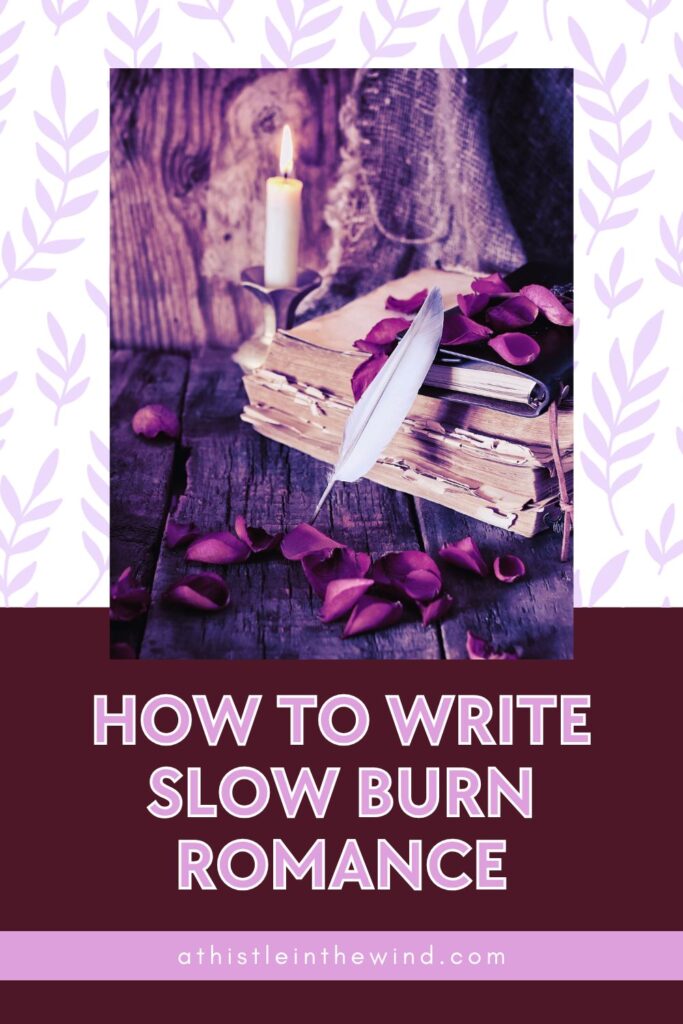
I’ve hit a bit of a writer’s block recently with the romantic subplot of my manuscript, especially since I’ve been recommended to write a slow burn love triangle. And it’s led me down this road where every scene I write reminds me of Twilight. The movie, not the book.
Now, as a writer, I’d love the frenzy around the whole “Team Edward/Team Jacob” debacle, but I don’t want to write stuff that would make you cringe. I mean, I guess sometimes you can’t help it. I personally adored Edward Cullen and hated Jacob. But my inclination towards Edward may or may not have to do with the fact that he was:
- A vampire, and
- He chose Bella
At the age of fourteen, that was gold. Not sure how I feel about it now (naturally). But I remember Twilight being fun. Not the best book but it was fun. I’ve never gone back to it. Never felt the need to. But it was fun when you’re a teenager.
I kind of want my readers to feel the same way about my book. Of course, unlike my perception of Twilight, I would love for them to rate it highly. But for the romantic subplot—I want it to be fun.
So, I started researching how to write slow burn romance. Because let’s be real, that’s the best kind of romance. One of the reasons I liked Air Awakens was because it was just enough. And that’s the key—it can keep your readers hooked; it’s the stuff that leads to fan fiction, and it’s the stuff that’ll make your book memorable.
Especially if romance is your genre. So, without wasting any more time, let’s take a closer look at writing slow burn romance.
Why Everyone Loves Slow Burn Romance
Personally, I think that before you start writing something, you need to be able to understand it. Truthfully, I knew what slow burn romance was but I wasn’t sure I understood it completely.
I guess from a writing perceptive, I made the mistake of thinking that it’s just a delayed confession of undying love. And yeah, it is that. But it’s not just that.
Slow burn romance thrives on delicious anticipation, creating a melting pot of emotions that keeps readers eagerly turning pages, desperate to see the culmination of the’ romantic arc. It should invoke suspense and thrill, making readers want to root for the characters by the story’s end.
Unlike whirlwind or instant romances, a slow burn deliberately resists speed. It needs to prioritize tension and uncertainty, allowing for complex character growth and realistic emotional arcs. This is critical because it makes the eventual confession feel incredibly earned and meaningful.
When readers become deeply invested, experiencing every moment of longing, doubt, and eventual realization alongside your characters, the payoff is exponentially more satisfying.
Building Your Characters from the Ground Up
At the very core of any romance story are the characters. If your readers aren’t invested in them, they won’t be invested in the romance. This means you need to establish a strong foundation for your characters right from the start.
Here’s how you do it:
- Develop well-rounded characters with clear goals, motivations, and flaws: Give them depth through backstories, experiences, personal feelings, and convictions that influence their approach to relationships. Characters who lack this depth can feel shallow and empty, making it hard for readers to be invested.
- Make sure your characters have weaknesses and strengths: Their weaknesses should make them believable. Nobody likes a Mary Sue. But don’t make them a damsel in distress either; their strengths need to shine through as well. This balance makes them significantly more relatable to your readership.
- Have dynamic characters: Your characters shouldn’t end the story the same way they began. They must go through some sort of shift, a satisfying character arc, reacting to major events and changes in their lives. Falling in love itself is a profound change, and you need to show how their other developments led them to embrace this one.
- Your characters need to have chemistry: The foundation of any thrilling slow burn romance is the undeniable chemistry between your characters. This isn’t necessarily instant attraction but a spark of connection that grows over time. It’s the way they challenge each other, complement each other’s strengths and weaknesses, and find themselves drawn together despite any initial obstacles. The tension needs to feel real and compelling, with subtle sparks rather than boredom.
For more information on how to write compelling characters, check out my blogs:
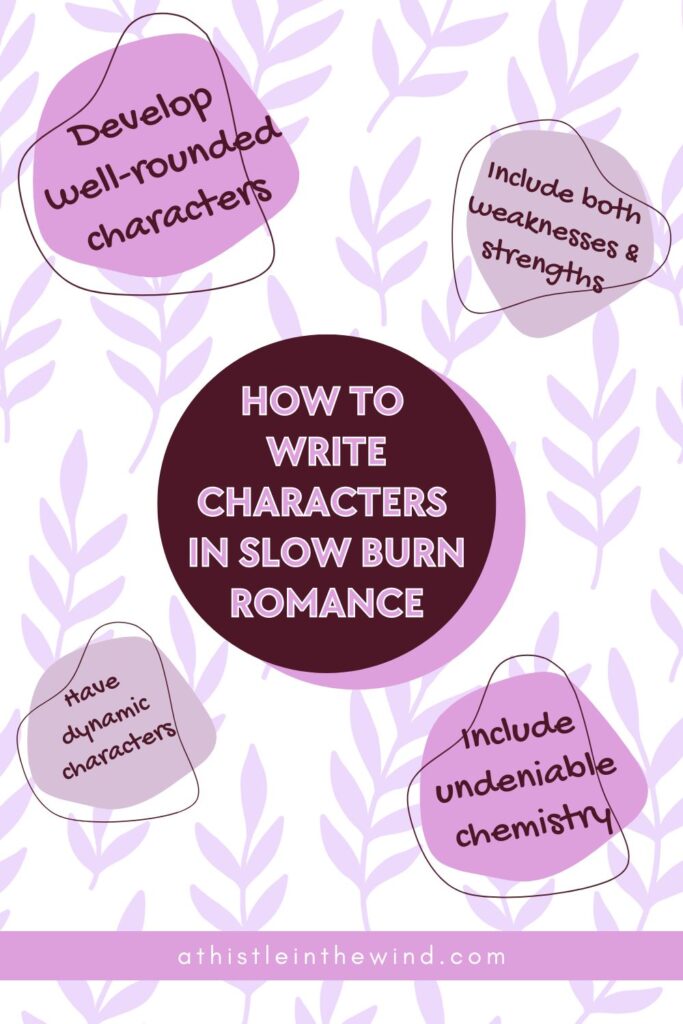
The Art of the Slow Build: How to Write Tension
So, this is where the magic truly happens. A slow burn romance lives and breathes on anticipation. You want your readers to be on the edge of their seats, just waiting for that moment when the tension finally peaks.
You’ll need to build the tension gradually, layering in small moments of intimacy and connection throughout your story. Here’s how you can do it.
1. Focus on the Little Things
Focusing on small details can help build romantic tension—soft smiles, maybe even a wink or two. These subtle gestures, charged silences, and lingering looks create a simmering connection. Let your characters inch closer emotionally and physically without rushing into declarations of love or physical intimacy.
2. Let Your Characters Pine
This is an essential element of a slow burn. Readers need to feel that pining coming from both characters, even if the story is told from only one person’s point of view. Show their constant thoughts, the flurry of anticipation, the pining feeling with both actions and words.
3. Include Subtle Interactions
Subtle interactions are important for building a relationship based on trust, emotions, and care. Small gestures like a comforting hug or a moment of mutual support help them build memories of each other, making the eventual confession feel well-earned. Even if your characters start as enemies, forced proximity can lead to situations where they need to help each other or open up, bridging their animosity.
4. Don’t Forget About Subtext
Not everything needs to be explicitly stated. Use subtext in dialogue and actions to hint at deeper feelings, allowing readers to read between the lines. Convey unspoken emotions and desires through body language, facial expressions, and internal thoughts, trusting your readers to understand.
5. Include Pivotal Moments
Don’t forget to incorporate pivotal moments that mark significant shifts in the characters’ relationship. These could be moments of vulnerability, shared triumphs, or near-misses that leave both characters and readers wanting more. These moments intensify the emotional connection and push them closer to acknowledging their feelings.

Keeping the Story Moving: Plot and Pacing
A slow burn doesn’t mean a slow pace. Most readers don’t want to read a slow-paced novel, so there needs to be other plot points happening while the romantic tension is building.
For more on pacing, check out my blog: On the Art of Pacing: A Writer’s Guide
Characters need to deal with other situations and have their own growth arcs alongside the developing romance, adding depth and making their eventual union more meaningful.
You have to create believable obstacles that keep the characters apart. These can be personal conflicts, stemming from their own lives, fears, or misunderstandings, or external obstacles like societal boundaries, rivalries, or other circumstances.
The point is, these need to feel authentic and not contrived; readers quickly lose interest if obstacles seem forced or unrealistic. These obstacles should genuinely test and challenge the characters and play a role in how their relationship is built.
Slow Burn Romance is a Balancing Act
While the slow burn should create anticipation, make sure that you balance everything. Provide moments of satisfaction along the way. Think small victories or tender moments that hint at the potential for a deeper relationship to keep readers engaged.
You also need to maintain consistent pacing throughout your story. Alternate moments of closeness with periods of distance or conflict. This stuff mirrors real-life relationships and maintains suspense. Avoid long stretches without any romantic progression, as this can cause readers to lose interest.
Here are some specific pacing techniques:
- Manage scene timing and breaks: Use chapter endings to create mini cliffhangers. A meaningful glance, an overheard secret, or a subtle touch can keep readers eager to turn the page without rushing the overall romance.
- Alternate perspectives and internal monologues: Switching between characters’ points of view or delving into their thoughts allows readers to experience the slow buildup of feelings from both sides, deepening emotional investment by revealing hidden hopes and fears.
- Strategic emotional reveals: Don’t reveal every feeling all at once. Let emotions unfold gradually through small actions or changes in behavior. This slow drip of intimacy feels more rewarding than immediate confessions.
- Avoid stagnation: While tension is crucial, too much waiting can frustrate readers. Introduce small romantic milestones or moments of connection regularly to maintain momentum.
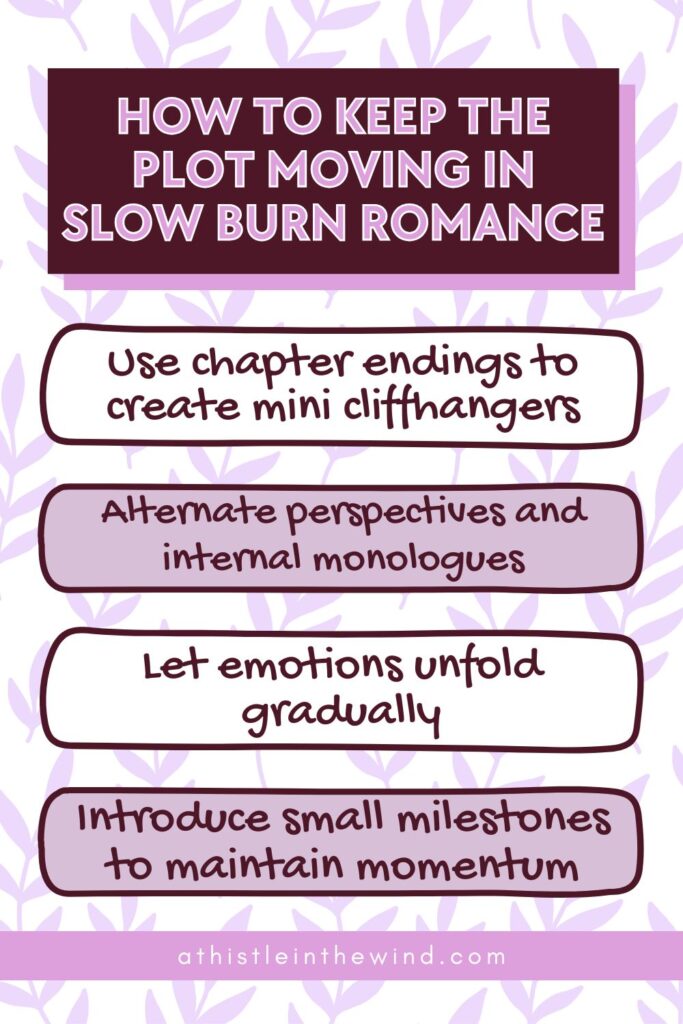
Popular Slow Burn Romance Tropes
If you’re confused about your characters’ dynamic, you can always refer to well-known tropes to help structure your slow burn romance. This provides familiar patterns that readers enjoy and can even help you with your elevator pitch.
Apart from that, romance tropes create frameworks for building tension and developing relationships gradually. Here are some popular romantic tropes:
- Friends-to-Lovers: Characters start as friends, building a strong foundation of trust before romantic feelings emerge.
- Enemies-to-Lovers: Characters initially dislike or have conflicts, but over time, their feelings transform into love, creating an exciting dynamic of tension and attraction.
- Forbidden Love: Characters face obstacles or societal boundaries that prevent them from being together, heightening anticipation.
- Second Chance Romance: Characters with a history reconnect, allowing for exploration of past regrets and personal growth.
- Opposites Attract: Characters with contrasting personalities find common ground despite initial friction.
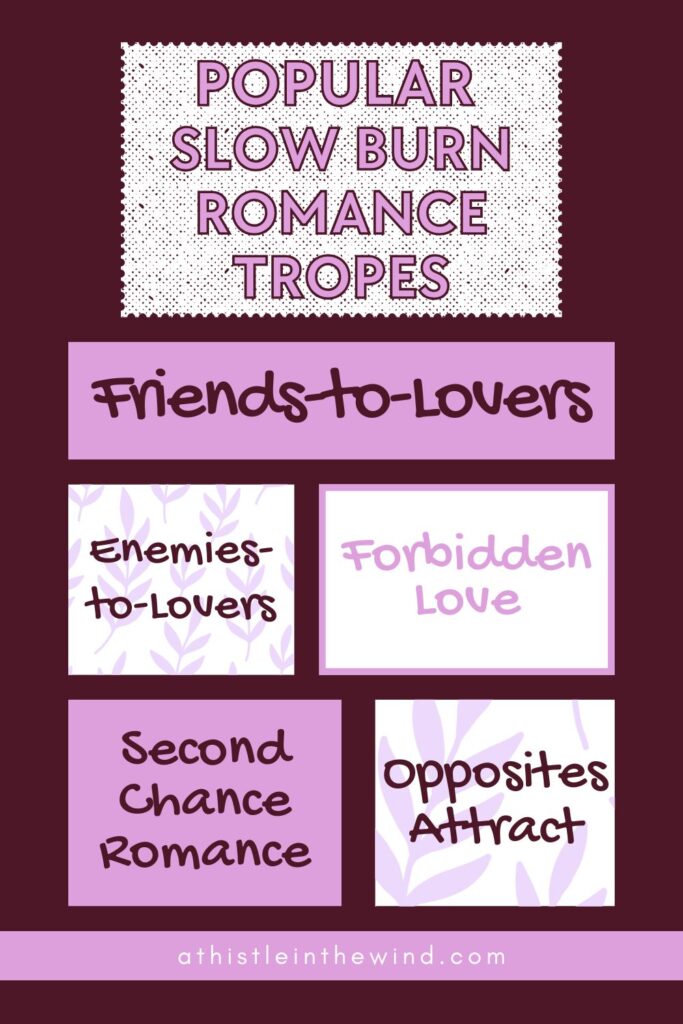
Common Mistakes to Avoid When Writing Slow Burn Romance
Writing a slow burn is a delicate art, and it’s easy to stumble into traps that can alienate your readers. Here’s what you should avoid:
1. Excessive Dragging
Taking too long to advance the relationship without meaningful development can frustrate readers. Each scene needs to add emotional or plot progression.
2. Lack of Chemistry
Slow burn doesn’t mean a lack of connection. The tension needs to feel real and compelling.
3. Overusing Misunderstandings
While obstacles are important, relying heavily on contrived drama or repetitive misunderstandings to delay the romance can feel manipulative and tiresome.
4. Losing Focus
Ensure you balance external plots with the romance itself. Don’t let one overshadow the other.
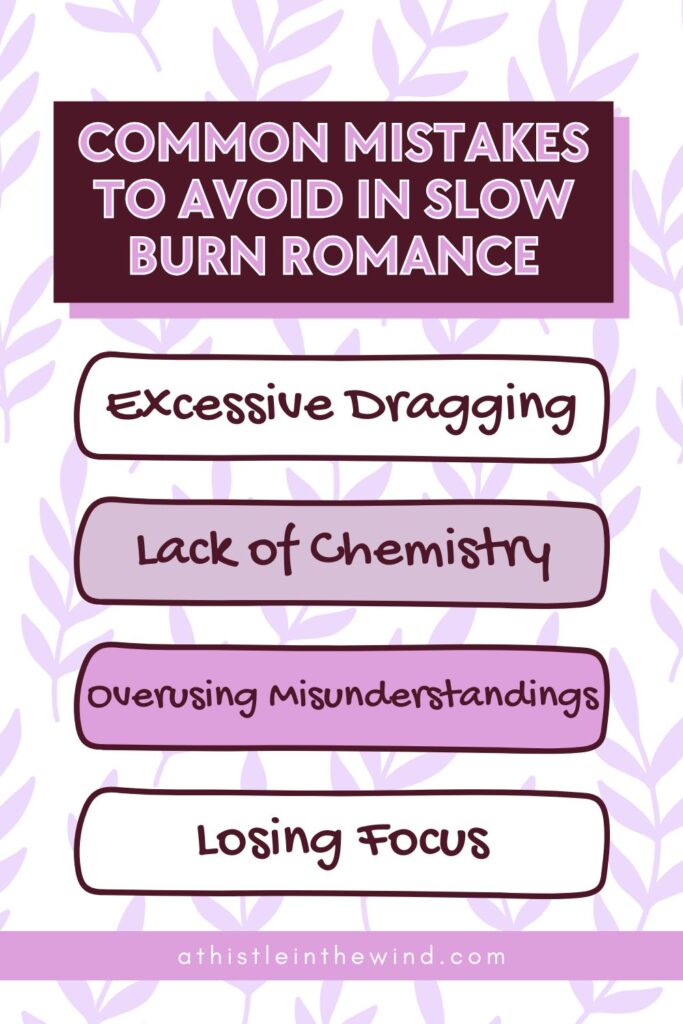
Writing The Confession: How to Deliver a Satisfying Payoff
After all that careful buildup, the eventual coming together of your characters is what readers have been waiting for, and it needs to be good. If you can’t do that—well, your story’s not going to go well with your readers.
- Make it memorable: When your characters finally confess and give in to their pining, you have to deliver a memorable climax. It could be a stellar and swoony first kiss or a goofy, rom-com style confession. Don’t be afraid to truly relish in the details.
- Make it feel inevitable: The moment of realization should feel earned and inevitable, the natural culmination of your character’s journey together. It should carry significant emotional weight.
- Make sure to resolve all conflicts: One of the biggest parts of ending a story with a slow burn romance is to ensure that conflicts are resolved by the end. Leaving too many open-ended conflicts, even in a series, can leave readers confused and unsatisfied. The confession of love should be a very special moment, not flat or on a sour note.
For romance novels, readers are often looking for a “happily ever after” where they know the couple will be happy together. The ending should provide emotional resolution for the readers.
The payoff is richer when characters acknowledge their struggles and commit to facing the future together, showing how they’ve grown and transformed because of their relationship. Whether it’s learning to trust, confronting fears, or breaking down emotional walls, their growth should feel authentic and significant.
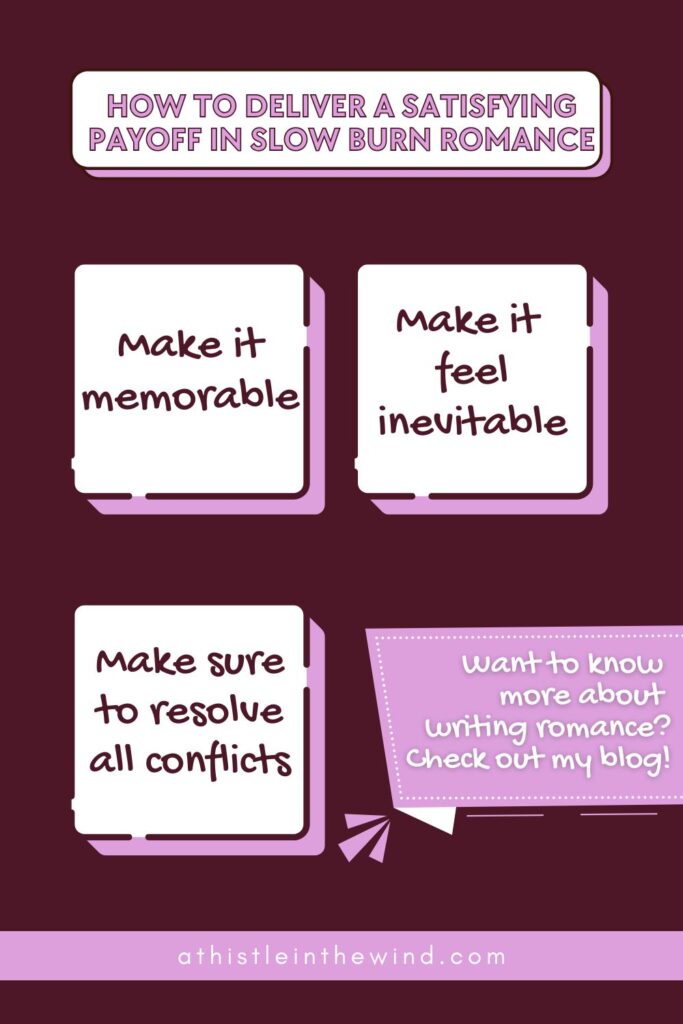
Draw Inspiration from the Classics
To truly master writing slow burn romance, look to successful examples. Consider classics like Jane Eyre by Charlotte Brontë. Seriously, it’s the quintessential slow burn with rich emotional tension and complex characters. Another example would be Outlander by Diana Gabaldon which weaves historical adventure with a slow-developing romance that unfolds across time and trials.
I’ve been reading stuff by Jane Austen a lot too recently—you’ll see what I mean in my September reading list. I really do stand by this. In addition to the points I’ve mentioned here, I think reading can really help you write better slow burn romance.
So, I’d say that you should definitely give it a go. Let me know if any of these tips helped you out!

One Comment
Laura Harber
I like this post, enjoyed this one thank you for putting it up!